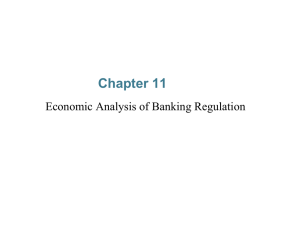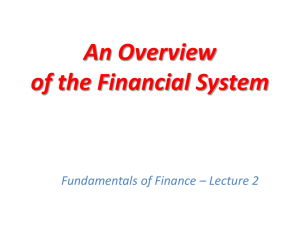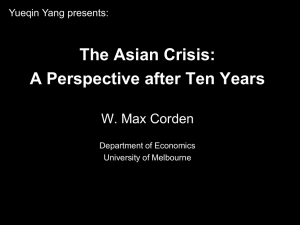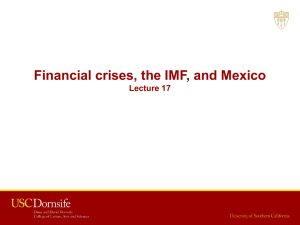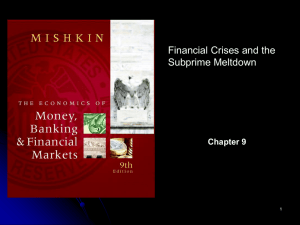The East Asian Financial Crisis: Diagnosis, Remedies, Prospects
advertisement
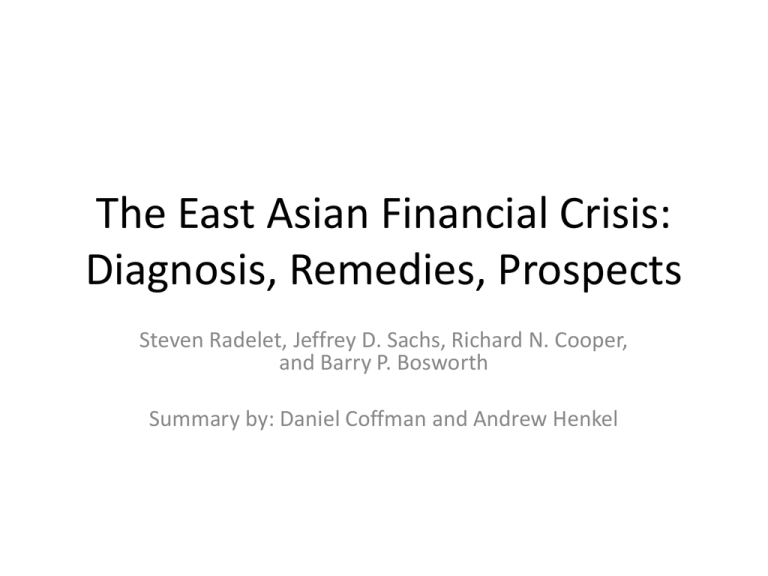
The East Asian Financial Crisis: Diagnosis, Remedies, Prospects Steven Radelet, Jeffrey D. Sachs, Richard N. Cooper, and Barry P. Bosworth Summary by: Daniel Coffman and Andrew Henkel Emerging Market Crisis • Crises often occur when economies that have been on the receiving end of large capital inflows stop receiving capital and instead face creditors demanding repayment • Sudden reversal of cash-flows often leads to default on loans, rescheduling of payments, or bailouts Self-Fulfilling Crises • Individual creditors may act rationally, but market outcomes lead to sudden reversals of cash-flows. • Difference between illiquidity and insolvency – Illiquidity: The borrower has the net worth to repay all loans, but lacks quick access to ready cash – Insolvency: The borrower does not have the net worth to repay loans • Even though the borrower may be solvent, they may not be able to get new loans to meet current debt obligations. • Leads to liquidity crisis • Root cause in international markets lies in the bank’s tendency towards herd behavior – Banks react to the activities of other banks instead of individual debtor’s attributes Domestic Markets • Domestic capital markets are less prone to self-fulfilling crises • Advanced economies have mechanisms to limit the onset of panics • In the United States, we have the Federal Reserve, which acts as the lender of last resort in the event of a bank run Was the East Asian Miracle A Mirage? • The rapid growth seen in many East Asian countries was real • The rapid expansion of the financial industries in many countries was not met with more complete regulation and oversight Response to the Crisis • In this article, the response is divided into two phases – Phase 1: August 1997 to December 24, 1997 – Phase 2: December 24, 1997 to April 1998 (publishing date) Phase One • Emergency lending agreements from the IMF – Thailand- $17B – Indonesia- $35B – S. Korea- $57B Loan Terms • Loans to be made available in order to repay debts and stabilize exchange rates • Economic planning to include budget balance or surplus, high nominal interest rates, and restrictive domestic credit targeted at exchange rate stability • Financial sector restructuring to include closure or suspension of several financial institutions and increased oversight of financial institutions Phase Two • Dec. 24, 1997- U.S. Government decides to press foreign commercial banks to roll over Korean short-term debt credits • Jan 28, 1998- $24B of Korean short-term debt is converted to claims with maturities between one and three years • Korean Won stopped depreciating, and decline of stock markets slowed in all three crisis countries • In Thailand, the government released a formal guarantee of all outstanding private and public liabilities to foreign creditors • In Indonesia, previous loan agreements with the IMF were intensified, followed by announcements of de-facto suspension of payments on short-term debt and the guarantee of all commercial debt. • Eventually these strategies worked and currency depreciation slowed Sources • Radelet, Sachs, Cooper and Bosworth (1998), “The East Asian Financial Crisis: Diagnosis, Remedies, Prospects,” Brookings Papers on Economic Activity, 1-90. What Caused the Asian Currency and Financial Crisis? Giancarlo Corsetti, Paolo Pesenti, Nouriel Roubini Ha-Joon Chang Two Views on the Causes • One view: Sudden shifts in market expectations—investor panic – Explored in detail in the Radelet & Sachs paper • Another view: Structural and policy distortions in many Asian countries Moral Hazard • Moral hazard at three different levels • Corporate: – Tradition of public guarantees to private projects led to ignoring costs and risks in project planning – Governments frequently coerced domestic financial institutions to make loans – High capital inflows despite sustained poor returns • Financial: – Excessive borrowing from abroad and domestic lending by national banks – Many structural distortions ranging from lax supervision and insufficient expertise to outright corruption – Non-performing loans came to constitute upwards of 10% of total lending on some countries Moral Hazard • International: – Substantial lending by international banks with little concern for risk assessment – Expectation of bailouts—“too big to fail” – Sustained economic stagnation in Japan affected trade balances by causing a slowdown in export growth – Appreciation of US dollar hurt cost-competitiveness – Competitive pressures increased due to China’s rising export economy – Reserves of foreign currency were insufficient in several countries to cover external obligations in the event of a liquidity crisis Macroeconomic Fundamentals • The countries hit hardest by the crisis had all been running substantial current account deficits throughout the 1990s—as high as 10% of GDP – Other economies in the region such as Singapore, Hong Kong or Taiwan were running current account surpluses • These countries also all had large foreign debt to GDP ratios • High rates of growth in the area that proved to be unsustainable were incorrectly projected into the future, promoting large capital inflows Macroeconomic Fundamentals • Investment efficiency was already falling in Asia even before the crisis – Most of the largest Korean chaebols had a return lower than their cost of capital • Political instability, such as that in Thailand and Indonesia, created additional market uncertainty Distress in 1997 • Thailand: Even before the crisis, a large number of Thai financial institutions were effectively bankrupt – Thailand ultimately had some 56 financial institutions go bankrupt after the government abandoned plans to bail out its finance sector in favor of trying to save the baht • Korea: The crisis was preceded by several bankruptcies among the chaebols in early 1997 – This led to a shocking drop in industrial growth and greatly affected the financial sector, which had borrowed abroad and loaned to many of the bankrupt companies Distress in 1997 • Malaysia: The central bank’s delayed response to a real estate bubble sparked a stock market crash in early 1997 – The Malaysian stock market continued to decline throughout the crisis • Japan: In 1997, an apparent recovery in the leading regional economy was wiped out by yet another recession Currency Crises • Speculation attacks were launched against many currencies in the region, which had been pegged to the dollar – First was the Thai baht, which was allowed to float in July – Malaysia, Indonesia and the Philippines were all subsequently targeted • Over the course of 1997, the values of these four currencies dropped precipitously by between 25% and 45% of their prior value • Speculation also was brought against Singapore, Taiwan, Hong Kong and Korea – The first three countries only suffered moderate depreciation, but the won ultimately dropped in value by almost half—25% in November 1997 alone Effectiveness of the IMF Response • The IMF-prescribed high interest rates may have contributed to the 1998 recessions by being sustained too long • The IMF’s handling of insolvent banks may have resulted in destabilization of otherwise healthy banks elsewhere in the region • IMF disbursements may have increased moral hazard issues on a global scale, though evidence suggests that not issuing this type of disbursement in a crisis likely has worse results than those created by moral hazard Global Effects • In 1998, the East Asian crisis spread to international markets • Hong Kong, Singapore, the Philippines and Taiwan all experienced recessions • Japan’s recession worsened • Commodities prices fell sharply, affecting Latin America • A severe economic crisis hit Russia following the collapse of its currency and threatened to affect US capital markets • Despite fears of a global recession, investor confidence improved near the end of the year, likely due to concerted US and international actions Sources • Chang, H-J. (2000), “The Hazard of Moral Hazard: Untangling the Asian Crisis,” World Development 28 no. 4, 775-788. • Corsetti, Pesanti and Roubini (1999), “What caused the Asian currency and financial crisis?” Japan and the World Economy 11, 305373.

